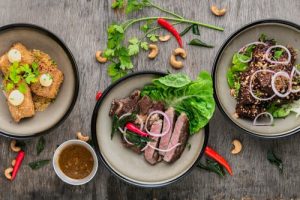 If you find yourself eating the same protein every night, below is a rundown of some popular protein sources to help shake up your dinner routine.
If you find yourself eating the same protein every night, below is a rundown of some popular protein sources to help shake up your dinner routine.
Protein is the building block of the human body and a crucial part of complete nutrition. Carbohydrates are easy to find or grab off the shelf, but protein-rich foods usually require a bit more preparation.
In phase 1, we’ve made protein intake easier for you—you’ll be able to choose from many Ideal Protein products for breakfast, lunch, and snacks. Our products are made with the highest quality protein to help keep you full longer. Our protein is delivered in an “isolate” form, which is absorbed faster to help transform your metabolism and protect lean muscle mass.
For dinner each night, you’ll eat a whole protein of your choice. Animal products are probably the source of protein you are most familiar with, but not all of them are appropriate for phase 1. During phase 1, you should look for lean sources of protein prepared without added oils and breading. There may be options below that you haven’t liked in the past, but that doesn’t mean you won’t like them prepared differently now—and if you still don’t, try some other options!
Here’s a rundown of some of the most popular protein sources (see your Ideal Protein phase 1 shopping list for specific recommendations for whole protein sources):
Beef
Beef is a great source of protein, but a diet based solely on beef could lead to high cholesterol and heart problems. Look for lean cuts of steak to pan grill or barbecue, or pot roasts for slow oven roasting or placing in your slow cooker. Extra-lean ground beef can be browned and seasoned or made into burger patties. The key to fantastic beef is a combination of seasoning and cooking time, so grab a meat thermometer the next time you’re out grocery shopping and avoid guessing when your beef is done.
Pork
No, we’re not suggesting you have bacon for breakfast! You can opt for lean ham or pork tenderloin, however.
Wild Game
Wild and/or organic game really does have distinctive flavor, so it can be an acquired taste. Venison, elk, and bison are all richly flavored, lean alternatives to beef.
Poultry
Tired of chicken breasts? We understand! Chicken is often touted as a superior protein because it’s lean, but chicken alone gets boring fast. Try roasting turkey drumsticks or breasts, or even a whole bird, in the oven. Wild birds like pheasant and game hens also offer lean, not-chicken protein options.
Seafood
Seafood is an excellent source of protein, and the variety in texture and flavor mean nearly everyone can find a type of seafood they love. Shellfish tend to be “sweeter,” but can become rubbery if overcooked, so prepare with caution. If you normally turn up your nose because fish smells or tastes too “fishy,” try branching out to other types of fish and preparation styles. Don’t forget that freshness is the single most important factor in the flavor of any type of seafood.
Tofu
Even if you aren’t a vegetarian, don’t ignore the protein offered by plants. Plain tofu offers the most protein bang per serving, and this boring-looking white block can be incredibly versatile and soaks up the flavor of whatever it is cooked with. Simply sub for chicken or fish in a recipe, or look for tofu-specific recipes.
Preparation
Seasoning is essential for any food, and doubly so for protein. If you’re attempting to cook something new, do a quick search for recipes to get an idea what spices and herbs will pair best. Choose packaged seasonings carefully, as they’re often little more than salt, and can contain hidden sugar. Check recommended cooking times and internal temperatures for meats to ensure you never overcook them again.
As you can see, there are many different types of protein foods to round out your phase 1 meals. Experiment with new-to-you varieties, and you just might find some new favorites!


